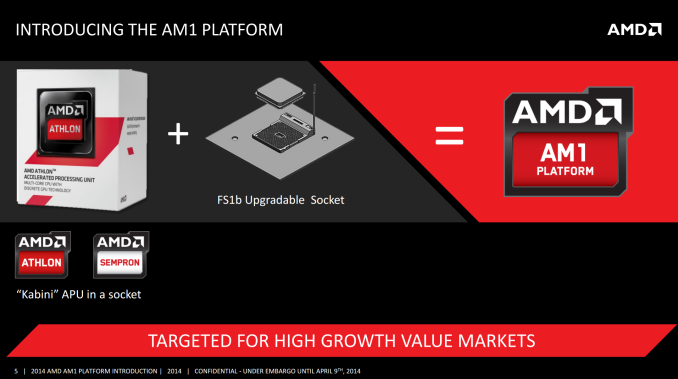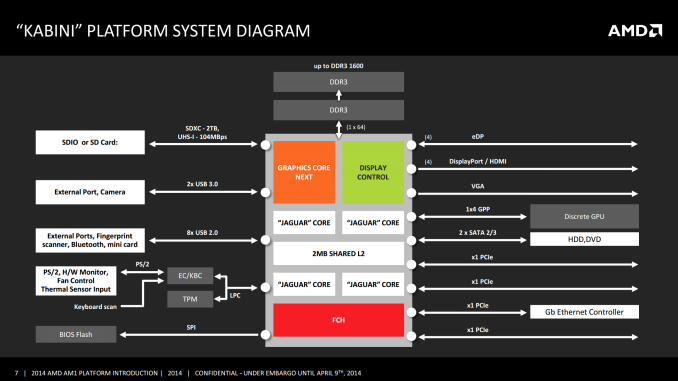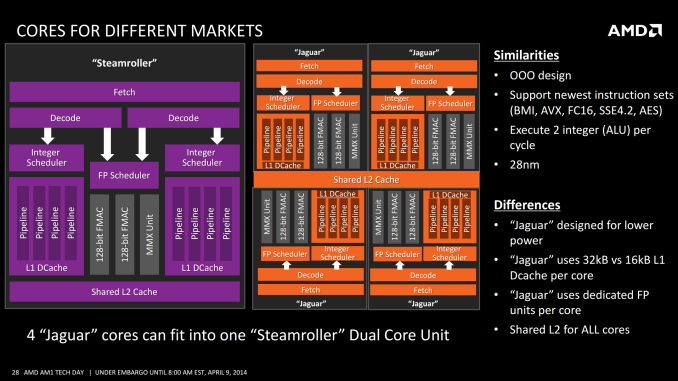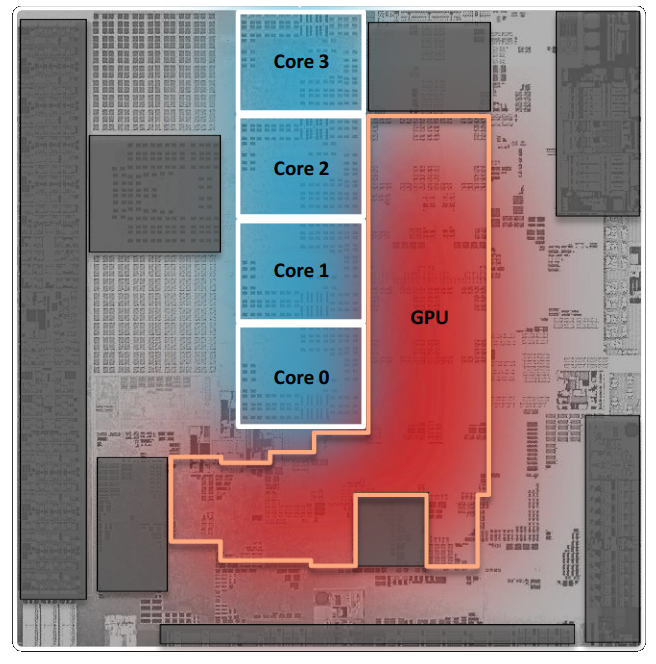AMD AM1 Kabini Part 2: Athlon 5350/5150 and Sempron 3850/2650 Tested
by Ian Cutress on May 29, 2014 2:00 PM EST
While there is a lot of focus on the mainstream desktop market, we hastily reviewed the new entrant to the low-end socketed desktop from AMD, the AM1 Kabini platform back in April. Since then we have acquired all four members of the family, the two quad core Athlon APUs and the two Sempron APUs, for testing. AMD’s movement into the upgradable tablet/desktop crossover arena is an interesting one for sure.
What Is The Point of AM1?
AMD’s reason for releasing a socketed low-power platform was derived from requests in low cost areas of the market. System integrators and companies in South America, Africa and Central Asia wanted a base system which would run an operating system which could be upgraded in the future to higher specification components, rather than sticking with a low-power but non-upgradable mobile CPU. The end result was AM1, the name given to a system using an FS1b socket with a desktop Kabini APU and an aim to build an upgradable CPU/motherboard combination for around $60.
Typically when dealing with the low cost/low power end of the spectrum, these systems are designed such that the APU is soldered on to the motherboard. When a user wants one model in particular, it comes as part of a package, much in the same way as a mobile device. In fact we even played a small game of ‘spot the desktop Kabini’ back at Computex 2013 and saw models such as the aptly named KBN-I from ECS, using the soldered A6-5200 APU:
These systems often find their way into applications that have long upgrade cycles, such as embedded and digital signage. The novelty of an upgradeable, socketed package makes most sense in the desktop arena. With low cost segments focusing more on the entry-level segmentation, AMD believe that having this upgradeability might drive pressure in the entry market towards these upgradeable PC-like devices.
AMD is marketing the series as a cheap, low powered way to go to quad core. When building a CPU architecture there is often a point in frequency scaling which is most efficient, and any deviation from that causes a less-than-linear gain in performance for power. Under this paradigm, and the importance of single core speed, the general feeling at AnandTech is that single core performance is preferred to more cores. If we can get the same multi-core performance using half the number of cores within the same power bracket, then this solution would be preferred. The final piece of that puzzle however comes in terms of design and price, both of which are points that AMD is also aiming to be competitive.
Desktop Kabini
There are a total of four AM1 APUs on the market:
| AMD AM1 Kabini APUs | ||||
| Athlon 5350 | Athlon 5150 | Sempron 3850 | Sempron 2650 | |
| CPU Cores | 4 | 4 | 4 | 2 |
| CPU Frequency | 2.05 GHz | 1.60 GHz | 1.30 GHz | 1.45 GHz |
| GPU Cores | 128 | 128 | 128 | 128 |
| GPU Frequency | 600 MHz | 600 MHz | 450 MHz | 400 MHz |
| Memory Frequency | 1600 MHz | 1600 MHz | 1600 MHz | 1333 MHz |
| L2 Cache | 2 MB | 2 MB | 2 MB | 1 MB |
| TDP | 25 W | 25 W | 25 W | 25 W |
| Official Launch Price | $59 | $49 | $39 | $31 |
Each of these APUs features up to four 28nm Jaguar cores and a 128 SP implementation of AMD's GCN GPU. We've gone over both the Jaguar and GCN architectures in previous articles, so we won't spend a lot of time recapping them here. Jaguar is the latest in AMD's line of "cat" cores, designed to go up against Intel's Atom. GCN on the other hand is a well-known GPU design from AMD as well, cut down here to fit in a much smaller die area (and thermal envelope).
The Jaguar cores in Kabini are listed as 3.1mm2, and AMD is quoting that four of these cores will fit into a single Steamroller module. Unfortunately the dimensions of a Steamroller module are not known - a 32nm SOI Bulldozer module clocked in at 30.9 mm2 for example, but no equivalent number is available for 28nm Steamroller. However some quick math shows four Jaguar cores populates 12.4 mm2. This leaves the rest of the core for the L2 cache, IGP and a large amount of IO.
In fact there are a few images that can help us predict total die size. In AMD’s slide deck, we have the following:
Given that one core is 3.1 mm2, extrapolating out gives the size of the die at 31.4x the size of a single core, or 97.3 mm2. The GPU area is approximately 5.2x the size of a core, giving ~16.1 mm2 for 128 GCN cores, compared to 12.4 mm2 for CPU cores. The Video Codec Engine and Unified Video Decoder are not part of these totals, located on other parts of the APU. The memory controller clocks in at ~9.4 mm2 and the display/IO portion runs at ~7.3 mm2.


















87 Comments
View All Comments
ET - Sunday, June 1, 2014 - link
I found the colours of the graphics confusing. Not only were they inconsistent (with the sometimes black, sometimes not) but I think it would have been better to also give the Bay Trail CPU's their own colour.And by the way, why 1280x1024? For historical reasons? 720p would be more reasonable. Can't say if it will get framerates to playable, but at least they'll be closer for this more real world resolution.
loimlo - Sunday, June 1, 2014 - link
Two suggestions :1. I suggest adding power consumption, fan noise to the review.
2. A few comments about Gigabyte motherboard like BIOS, fan control would be nice.
carol45 - Monday, June 2, 2014 - link
Really nice test. Maybe i will convince to AMD thanks this test. http://forum.notebookreview.comPPB - Wednesday, June 4, 2014 - link
No LoL or any other actually popular game benchmarks but instead some AAA games being tested? Just wow.Can someone tell me with a straight face they will be buying a kabini to play Tomb Rider? :rolleyes:
HeyHey!!!345 - Monday, August 18, 2014 - link
It seems the new chips greatly bottlenecks high-end graphics card. What about mid-range?? I plan to get a Sempron 3850 as a cheap build for my cousin since he's on a tight budget. Would it bottleneck that great with graphics cards say an HD7770 or even a GTX 750??Jeris Boltsin - Monday, November 24, 2014 - link
Athlon 5350 + GTX 750 Ti ==> http://www.pcper.com/image/view/39798?return=node%...(Considering how "powerful" the CPU is, I'd personally would've liked to also see 720p results, to see what kinda difference that would've made)
Of couse, if they'd used those ASUS mobos & overclocked that 5350, the result might've been a little better, with some games. And before anyone even asks: There's a video on YouTube where some dude overcloked it to 2709 Mhz, using Asus AM1I-A and the stock heatsink & fan.
Some other people have managed to go up to 3 Ghz with 5350s, using water cooling - but "money doesn't grow on trees" and all that.
Gnet - Friday, February 25, 2022 - link
GnetGnet is one of the Best Broadband and Internet Service Providers in Bangalore. Here you can expect zero downtime internet services for home and office. Get a new broadband connection from G-Internet Service Providers. Check out the new broadband plans now, Amazing offers waiting for you. We are providing unlimited data for our customers at affordable prices starts @499. Check out the Gnet broadband internet plans here. Enjoy your unlimited data internet forever.
Our vision is to be the leading Broadband Service Provider in Bangalore, offering innovative services and solutions to Home, Offices, and other Customers. We believe that our next-generation services will transform the way people live, translate and communicate and the internet is going to play a big role in it and we at Gnet Broadband believe that we can make a significant contribution towards this revolution. for more info (https://www.ginternet.in/index.html)